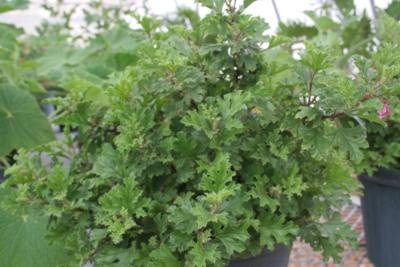Pelargonium pseudoglutinosum
Pelargonium pseudoglutinosum R.Knuth
Family: Geraniaceae
Common names:
Introduction
This is a fairly large, attractive pelargonium, which flowers throughout the year.

Description
Description
Pelargonium pseudoglutinosum is an erect to decumbent well branched shrub, 1 m high and 1.25 m in diameter. The stems are soft and green when young but become woody when older. Numerous glandular hairs are present, interspersed with long soft hairs which are green but age to wine-red and eventually brown when older. Its leaves are ovate, with the leaf margin deeply lobed, almost hairless and sticky. The larger veins on the adaxial (upper) surface of the leaf are often dark purple.

The fairly large flowers occur in pairs or are solitary, and are pale pink to pink with a dark pink blotch and purple markings on the posterior (upper) petals. The shrub flowers from September to January with odd flowering times throughout the year.

Conservation Status
Status
Pelargonium pseudoglutinosum is listed on the National Red List of South African plants as Least Concern (assessed February 2009, www.sanbi.org).
Distribution and habitat
Distribution description
Pelargonium pseudoglutinosum has a limited distribution in the southern Cape. It is only known in the areas of Prince Alfred's Pass, Mannetjiesberg, Keurboomsrivier and Uniondale. It grows along water streams in ravines on well drained soil. The areas in which it grows receive an annual rainfall of 200 mm. This is spread evenly throughout the year. Frost is experienced in winter while high temperatures occur in summer.

Derivation of name and historical aspects
History
Pelargonium pseudoglutinosum belongs in the family Geraniaceae, a large family of 11 genera and 800 species in subtropical and temperate regions of the world. The South African genera in the Geraniaceae family are Monsonia, Sarcocaulon, Pelargonium, Erodium and Geranium. There are approximately 270 species of Pelargonium which occur in S, E and NE Africa, Asia, St Helena, Tristan da Cunha, Madagascar, Australia and New Zealand, most of which (± 270 species) occur in southern Africa, and ± 150 species are found in fynbos. Pelargoniums are often wrongly called geraniums. Pelargonium gets its name from the resemblance of the shape of the fruit to the beak of a stork, which is pelargos in Greek. The epithet pseudoglutinosum refers to the resemblance between this species and Pelargonium glutinosum. The word pseudo means false, glutinosus means sticky.
Ecology
Ecology
The seed is adapted to wind dispersal. Once it reaches the ground it bores its way into the soil. This is possible due to the corkscrew tail attached to the end of the seed. As the wind blows, so the corkscrew turns, much like a drill bit.

Uses
Use
Although Pelargonium pseudoglutinosum has no cultural use, horticulturally it is an attractive species. When gardening with P. pseudoglutinosum it is best to grow it in a moist area of the garden. The flowers are large and attractive, making this plant very conspicuous when it is in flower, providing almost year-round colour. If pruned, the plant will stay compact. It requires much water to establish and to encourage rapid and healthy growth.
Growing Pelargonium pseudoglutinosum
Grow
Pelargonium pseudoglutinosum can be propagated from both seeds and cuttings. Cuttings can be taken at any time of the year from a healthy vigorous plant, from softwood or herbaceous growth. Using a rooting hormone powder will speed up the rooting process, especially for the softwood cuttings. Place the cuttings in river sand in cold frames and keep them moist. The cuttings should root within 3 weeks. Give the rooted cuttings a 2-week weaning period and transplant them into a well-drained potting soil mix and place them in a sunny position. When they have formed a strong root-ball they can be planted out into the garden.
Sow seeds in late summer to early autumn. The seed should be sown in a light, well-drained potting mix. Sprinkle the seeds evenly in the seed tray and cover them with fine-milled pine bark. Water the seeds gently but thoroughly with a fine-nozzled watering can and place them in light shade with no direct sun. Seed germinates in 2 to 3 weeks. Plants grown from seeds will flower within 12 to 18 months. Pelargoniums grow happily outdoors free of diseases, but if the same plant is grown indoors or in a greenhouse the warmer climatic conditions and lack of air circulation usually result in pests such as aphids, white fly or rust and powdery mildew. Consult the nearest garden centre to find out what the latest and best suited pesticide and fungicides are for the problems.
References
- Brown, N. & Duncan, G. 2006. Grow Fynbos plants . South African National Biodiversity Institute. Cape Town.
- Goldblatt, P. & Manning, J.C. 2000. Cape plants. A conspectus of the Cape flora of South Africa. Strelitzia 9. National Botanical Institute of South Africa, Cape Town and Missouri Botanical Garden.
- Van der Walt, J.J.A. & Vorster, P.J. 1988. Pelargoniums of southern Africa , vol. 3. Kirstenbosch National Botanical Gardens, Cape Town.
- website: National Red List of South African plants. http://redlist.sanbi.org.
Credits
Trevor Adams
Kirstenbosch National Botanical Garden
February 2013
Plant Attributes:
Plant Type: Shrub
SA Distribution: Eastern Cape, Western Cape
Soil type: Sandy
Flowering season: Spring, Early Summer, Sporadic/All year
PH: Acid
Flower colour: Pink
Aspect: Full Sun, Morning Sun (Semi Shade), Afternoon Sun (Semi Shade)
Gardening skill: Easy
Special Features:
Horticultural zones










Rate this article
Article well written and informative
Rate this plant
Is this an interesting plant?
Login to add your Comment
Back to topNot registered yet? Click here to register.